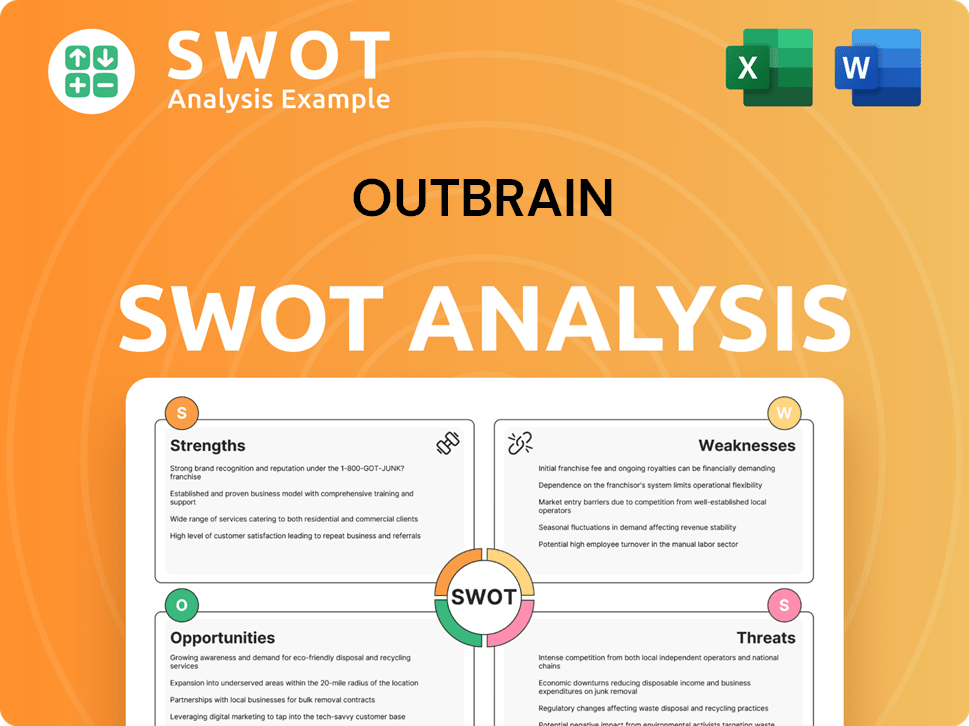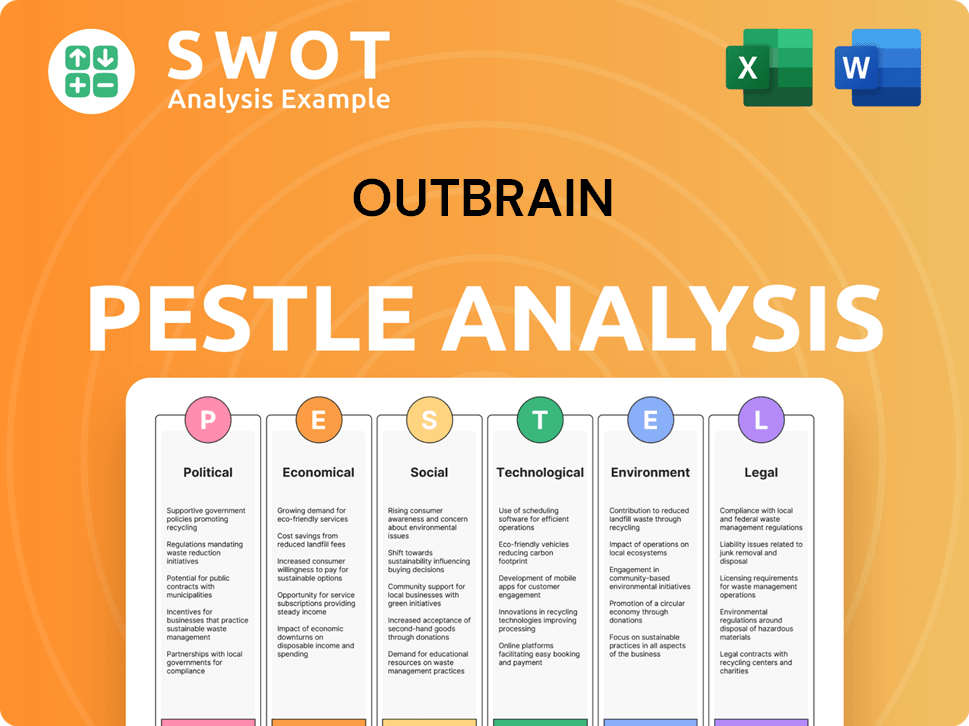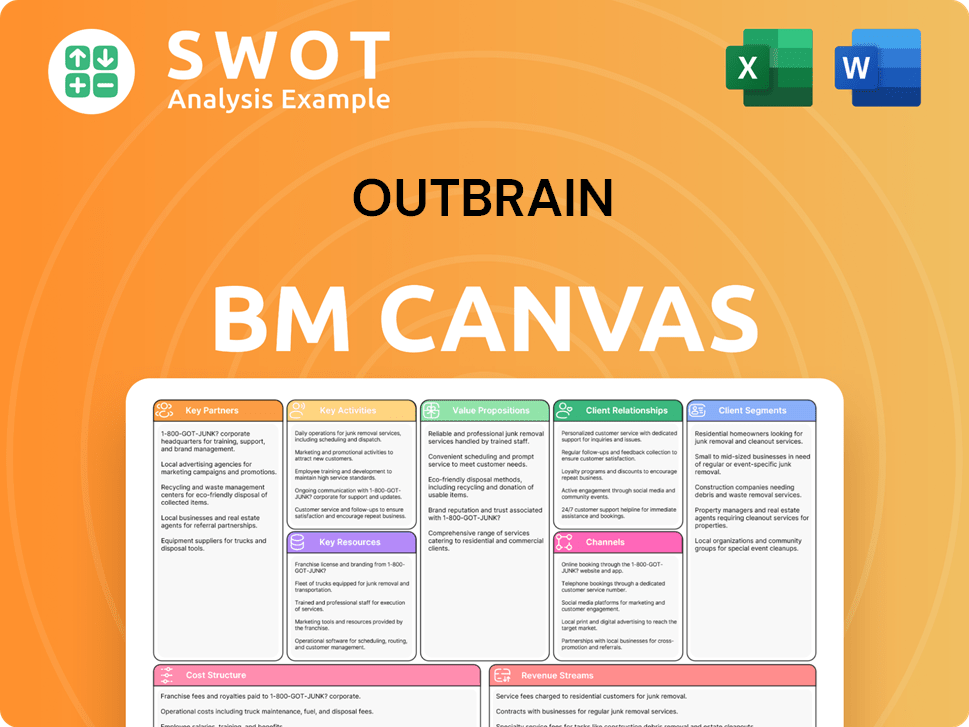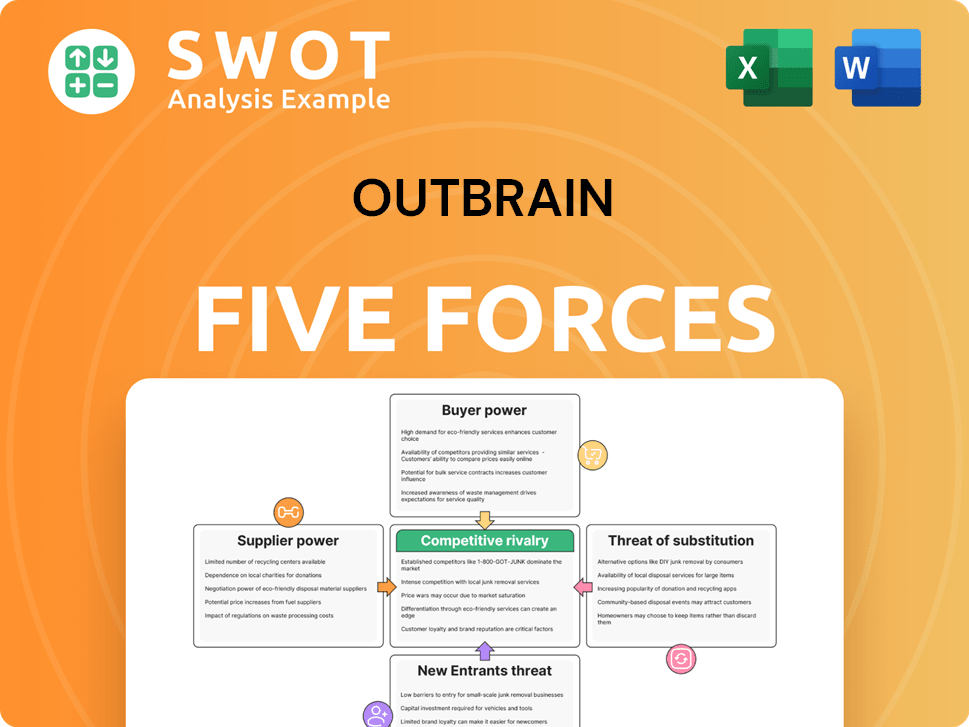Outbrain Bundle
What's the Story Behind Outbrain?
Ever wondered how you find those captivating articles at the bottom of websites? Outbrain, a pioneer in the digital advertising world, has been quietly revolutionizing content discovery since 2006. This Outbrain SWOT Analysis reveals the company's strategic positioning. From its humble beginnings in Israel, Outbrain has transformed how we consume information online.

This article delves into the Outbrain company history, exploring its evolution from a content recommendation engine to a major player in native advertising. We'll examine the
What is the Outbrain Founding Story?
The story of Outbrain, a prominent player in the content recommendation space, began in 2006. The company was founded by Yaron Galai and Ori Lahav, both of whom brought unique experiences to the table. Their vision was to transform how users discover content online, focusing on a seamless and user-friendly experience.
Galai and Lahav, veterans of the Israeli Navy, recognized the challenges publishers faced in directing users to relevant content. They also saw the intrusive nature of many online advertisements. This insight led them to create a platform that would not only help publishers but also enhance the user experience. Their goal was to create a content discovery platform that would seamlessly recommend articles, videos, and other content to users.
The founders' background in ad technology and e-commerce provided a strong foundation for their new venture, which has significantly impacted the online publishing landscape.
Outbrain's initial business model centered on 'chumboxes' or content feeds, which displayed content and ads. These linked to the publisher's content or sponsored content from advertisers. Advertisers paid on a pay-per-click basis, with a portion of the revenue shared with publishers. Understanding Outbrain's Target Market is key to appreciating its impact.
- Outbrain's launch date was in 2006, marking the beginning of its journey in the content recommendation field.
- Early funding included seed rounds, with Index Ventures leading a $5 million round.
- A $35 million Series D funding round in 2011 fueled international expansion and product development.
- Yaron Galai, the CEO for many years, had experience in the ad-tech industry, having sold his company Quigo to AOL in 2007.
Outbrain SWOT Analysis
- Complete SWOT Breakdown
- Fully Customizable
- Editable in Excel & Word
- Professional Formatting
- Investor-Ready Format

What Drove the Early Growth of Outbrain?
The early growth of the company, a key player in the online advertising space, was marked by significant technological advancements and strategic expansions. The company's initial focus on content recommendation evolved into a broader platform for native advertising. This period saw the company establish itself as a major force in the digital media landscape through innovation and strategic acquisitions.
The company launched its first algorithmic-based content recommendation on publisher sites in 2008, marking its entry into the online advertising industry. In 2009, it enabled publishers to acquire new traffic, expanding its services beyond simple content recommendations. The introduction of paid content in 2010 further diversified its offerings, providing new revenue streams for publishers and advertisers.
A significant milestone was the launch of the industry's first self-serve platform in 2012, empowering more publishers and advertisers. The company expanded its technological capabilities and market reach through acquisitions. In 2013, the company acquired Visual Revenue, and later that year, it actively purged 'fake news' from its network, demonstrating an early commitment to content quality.
Major capital raises, such as the $35 million Series D funding in 2011, enabled international expansion. The company continued to grow its technological capabilities and market reach, adding native RTB (Real-Time Bidding) to its programmatic offering in 2016 and acquiring Zemanta, a native DSP (Demand-Side Platform), in 2017. The company's financial performance in 2024 saw a revenue of $889.9 million, with a gross profit of $192.1 million.
In Q1 2025, the company's revenue increased by 32% to $286.4 million compared to Q1 2024, primarily due to the acquisition of Teads. The company's strategic focus on integrating Teads and expanding its offerings has contributed to its growth. CTV revenues grew by over 100% year-over-year in Q1 2025. For more insights, consider reading about the Marketing Strategy of Outbrain.
Outbrain PESTLE Analysis
- Covers All 6 PESTLE Categories
- No Research Needed – Save Hours of Work
- Built by Experts, Trusted by Consultants
- Instant Download, Ready to Use
- 100% Editable, Fully Customizable

What are the key Milestones in Outbrain history?
The Outbrain company has marked several significant milestones throughout its history, consistently adapting to the evolving digital advertising landscape. These advancements have helped shape its position in the online advertising industry, particularly in content recommendation and native advertising.
| Year | Milestone |
|---|---|
| 2014 | Launched the industry's first content-marketing API for programmatic buying. |
| 2017 | Introduced Smartfeed technology, a dynamic, personalized feed experience for publishers. |
| 2024 | Introduced 'Moments,' an immersive vertical video offering designed to bring social media-like experiences to the open internet. |
| 2025 | Completed the acquisition of Teads. |
The Outbrain company has consistently innovated to stay ahead in the competitive digital advertising market. A key aspect of their strategy has been to leverage technology to improve user engagement and provide value to publishers and advertisers alike.
Smartfeed technology, launched in 2017, provides a dynamic, personalized feed experience. This innovation enhanced user engagement and boosted revenue for publishers.
In 2014, Outbrain pioneered the industry's first content-marketing API for programmatic buying. This allowed for more efficient and automated buying of content promotion.
The introduction of 'Moments' in 2024 brought an immersive vertical video experience to the open internet. This initiative aimed to attract new ad investment and enhance user engagement for publishers.
Accelerated AI integration, particularly in performance and creative offerings, is a key focus. Collaborations with Microsoft Azure to integrate Azure OpenAI solutions enhance creative automation tools.
The acquisition of Teads in February 2025 for approximately $900 million is a strategic move. This aims to create an omnichannel outcomes platform.
Despite its successes, the Outbrain company has faced challenges, including intense competition and evolving market dynamics. These challenges require strategic pivots and technological advancements to sustain growth and profitability.
The digital advertising space is highly competitive, which can pressure margins. This necessitates continuous innovation and differentiation to maintain a competitive edge.
Economic instability can impact advertising budgets and overall market demand. Adapting to these fluctuations is crucial for sustained performance.
Evolving data privacy regulations pose ongoing risks and require compliance adjustments. Staying compliant is essential for maintaining user trust and avoiding penalties.
Integrating new technologies and acquisitions, such as Teads, can be complex. Successfully integrating these elements is key to achieving expected synergies and growth.
Achieving the expected synergies from the Teads acquisition is vital for financial performance. Outbrain anticipates approximately $65 million to $75 million in annual synergies by 2026, with about $40 million expected in 2025.
Outbrain Business Model Canvas
- Complete 9-Block Business Model Canvas
- Effortlessly Communicate Your Business Strategy
- Investor-Ready BMC Format
- 100% Editable and Customizable
- Clear and Structured Layout

What is the Timeline of Key Events for Outbrain?
The Outbrain company has a rich history, marked by significant milestones in the online advertising industry. Founded in 2006 by Yaron Galai and Ori Lahav, the company quickly became a key player in content recommendation and native advertising.
| Year | Key Event |
|---|---|
| 2006 | Outbrain founded in Giv'atayim, Israel. |
| 2008 | Launched first algorithmic-based content recommendation on publisher sites. |
| 2011 | Raised $35 million Series D funding, fueling international expansion. |
| 2012 | Launched the industry's first self-serve platform. |
| 2013 | Acquired Visual Revenue and began purging 'fake news' from its network. |
| 2014 | Launched the industry's first content-marketing API for programmatic buying. |
| 2017 | Launched Smartfeed technology, enhancing personalized content feeds. |
| 2021 | Outbrain went public, raising $160 million through its IPO. |
| 2024 (Q3) | Beta launch of 'Moments' vertical video product. |
| 2024 (Full Year) | Reported revenue of $889.9 million. |
| 2025 (February 3) | Completed the acquisition of Teads. |
| 2025 (Q1) | Reported revenue of $286.4 million, a 32% increase year-over-year. |
The new Teads, post-acquisition, aims to become an omnichannel outcomes platform. This strategy focuses on driving full-funnel results for marketers across premium media channels. The goal is to provide comprehensive solutions for online advertising.
The company anticipates approximately $65 million to $75 million in annual synergies from the Teads acquisition by 2026. About $40 million of these synergies are expected to be realized in 2025. For Q2 2025, the company expects Ex-TAC gross profit of $141 million to $150 million.
Future growth will likely be driven by AI-powered recommendation technology and expansion into new content environments like CTV. The company is well-positioned to leverage the combined strengths of Outbrain and Teads to offer comprehensive advertising solutions on the open internet.
Analysts have given Outbrain a consensus rating of 'Buy,' with a price prediction of $7.49 for 2025. This indicates optimism about the company's prospects, despite recent stock fluctuations. The company's focus on cost synergies is a key factor.
Outbrain Porter's Five Forces Analysis
- Covers All 5 Competitive Forces in Detail
- Structured for Consultants, Students, and Founders
- 100% Editable in Microsoft Word & Excel
- Instant Digital Download – Use Immediately
- Compatible with Mac & PC – Fully Unlocked

Related Blogs
- What is Competitive Landscape of Outbrain Company?
- What is Growth Strategy and Future Prospects of Outbrain Company?
- How Does Outbrain Company Work?
- What is Sales and Marketing Strategy of Outbrain Company?
- What is Brief History of Outbrain Company?
- Who Owns Outbrain Company?
- What is Customer Demographics and Target Market of Outbrain Company?
Disclaimer
All information, articles, and product details provided on this website are for general informational and educational purposes only. We do not claim any ownership over, nor do we intend to infringe upon, any trademarks, copyrights, logos, brand names, or other intellectual property mentioned or depicted on this site. Such intellectual property remains the property of its respective owners, and any references here are made solely for identification or informational purposes, without implying any affiliation, endorsement, or partnership.
We make no representations or warranties, express or implied, regarding the accuracy, completeness, or suitability of any content or products presented. Nothing on this website should be construed as legal, tax, investment, financial, medical, or other professional advice. In addition, no part of this site—including articles or product references—constitutes a solicitation, recommendation, endorsement, advertisement, or offer to buy or sell any securities, franchises, or other financial instruments, particularly in jurisdictions where such activity would be unlawful.
All content is of a general nature and may not address the specific circumstances of any individual or entity. It is not a substitute for professional advice or services. Any actions you take based on the information provided here are strictly at your own risk. You accept full responsibility for any decisions or outcomes arising from your use of this website and agree to release us from any liability in connection with your use of, or reliance upon, the content or products found herein.